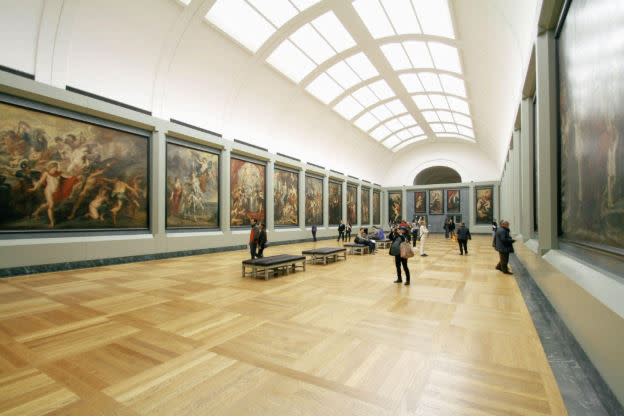Heritage Access Guide
You can download a .PDF of the content on this page.
Improving Access within the Heritage Sector, Listed Buildings and Landscapes
According to specialist heritage insurer Ecclesiastical, 77% of those working in the heritage sector feel that advancements in accessibility are extremely or very much prioritised at their organisation, making inclusive heritage improvements a top focus for many in 2023 and beyond.
But how, with structural constraints and conservation needs, can we ensure heritage buildings and landscapes provide more equitable experiences to disabled people, whilst still being protected and celebrated for their history and purpose? This guide will share some top tips to help build confidence around these conversations and actions.
Contents
- An Introduction to the Heritage Sector
- Internal and External Experiences
- Creating an Access Framework
- The ‘As-Is’ Scenario
- Accessibility Challenges and Reasonable Adjustments
- Further Information and Guidance
An Introduction to the Heritage Sector
The heritage sector plays an important role within UK tourism. Local people and those from all over the world visit heritage sites - whether castles, cathedrals, museums or monuments - to learn more about history, the importance of identity and belonging, and to get a sense of the distinction between past and present.
It’s vital that everyone has the opportunity to gain access to the education, experiences and enjoyment that the heritage sector can bring, and it is a legal requirement under the Equality Act (2010) for service providers and employers not to discriminate against visitors and staff members with protected characteristics. This includes those with additional requirements who may be disabled, and more information can be found in Module 2, Your Inclusive Responsibilities and Duty of Care.
However, improving accessibility in older, and often listed, buildings is not always easy. If you are passionate about making the heritage sector more inclusive but don’t quite know where to start, this guide is for you.
Internal and External Experiences
First, consider what you’d like to make more accessible. Is it internal access to exciting exhibits, information or facilities within a building, or the external experience of exploring the venue grounds, navigating to points of interest and enjoying inclusive dwell spaces?
Whilst your considerations will likely be different (widening access routes, and implementing smooth surfaces and contrasting street furniture externally, versus ensuring inclusive vertical circulation, and access to accessible toilets or quiet areas internally), the principles should be the same. Think about what you can do to promote better:
- physical access within the built environment,
- digital access on websites and apps,
- and social access in terms of staff empathy and operations.

Photo by Spencer Davis
Creating an Access Framework
Once you’ve identified the physical, social and digital accessibility improvements you would like to make, an access framework or strategy should be developed. This should include:
- An idea of costs, budget available and where to apply for additional funding, if required.
- An awareness of the planning permission, listed building and/or scheduled monument consent that would be required to implement the improvements.
- The prioritisation of improvements into ‘quick wins’ and longer term goals and an established timeline for completion (see the Quick Wins guide for more information on this). It might be that only a small amount of improvements are possible in the shorter-term; that is absolutely fine, so long as action is taken and your visitors and staff are clearly and honestly informed.
- An idea of ownership. Who will champion these improvements, and which stakeholders need to also be involved in the journey? Would you like to discuss several possible improvements with stakeholders who have lived experience of disability before taking any action, for example? Or perhaps a conservation architect needs to review plans to ensure accessibility improvements do not risk building safety and protection, and that any alterations to the built environment can be made sensitively. Gaining support from senior members of your organisation from the outset would also be advised, as these improvements will undoubtedly have managerial and operational impact, too.
Your ‘AS-IS’ Position
To ensure you are correctly planning for a more inclusive visitor, staff and volunteer experience in the future, it is important to have a good understanding of where you are now; your ‘AS-IS’ is your current position with regards to your accessibility journey. To get a good understanding on your current accessibility position, two activities should be undertaken:
- Qualified accessibility consultants should be hired to complete a pan-disability access audit of your venue, focusing on the needs of those with physical, sensory and cognitive impairments, the current barriers related to equitable access and any recommendations to remove those barriers.
- Any visitors and staff members with lived experience of disability should be asked what they think of your current provision and how it caters to their specific requirements. Lived experience consultation should be an ongoing activity throughout any accessibility improvement project (and setting up your own accessibility steering group would be strongly recommended), but getting a general idea of current triumphs and grievances is a good place to start!
If the results of these two activities do not quite align with your access framework, feel free to amend and adapt as you see fit. Then, once any necessary agreements have been made and stakeholders consulted - particularly in relation to planning and conservation needs - it is time to start taking action!


Photo by Riccardo
Accessibility Challenges and Reasonable Adjustments
Making heritage venues accessible comes with its challenges; our opinions on the importance of accessibility, and the diversity of visitors and staff members we need to cater to, has changed considerably over time. Whilst this is excellent and much-needed, unfortunately buildings and landscapes do not automatically change with us!
The most important thing to remember when improving accessibility is the end goal; this should be for disabled people and those with other accessibility requirements to be able to have an equitable experience to their non-disabled peers. So, in order to achieve that, reasonable adjustments will likely need to be made. Whilst what is reasonable needs to be decided on a case-by-case basis, these pointers from the Equality and Human Rights Commission should help. Consider:
- how effective the change will be in avoiding the disadvantage the disabled visitor or employee would otherwise experience
- its practicality
- the cost
- your organisation’s resources and size
- the availability of financial support
To overcome an accessibility challenge or barrier that is presented by a certain feature in the physical, built environment (whether a lack of barrier-free entrance to a certain part of the building, landscapes with uneven surfaces and steep gradients, or narrow doorways and staircases, for example) the Equality Act (2010) states that these four options should be considered:
- removal of the feature
- alterations to the feature
- providing a reasonable means of avoiding the feature
- If the above three options are not possible or reasonable, providing the service in a different way
Below are four examples of how these differing options could be achieved:
Example 1: Removal
Perhaps street furniture is blocking a clear width access route in your historic landscape, or a reception desk makes entry into a certain area of your historic venue difficult for visitors with mobility equipment. If the elements do not have particular historical significance and it is possible to do so from a conservation standpoint, removing these features or placing them elsewhere may be the most reasonable action.
Example 2: Alteration
Sometimes, it may be possible, and most reasonable, to alter a feature without causing historic damage to the venue or landscape and its quality or fabric. Widening doors may be possible, for example, or altering desk heights for seated and standing visitors and members of staff. Room design may need to be slightly altered to install an induction loop or improve sightlines to a stage, for example.
Example 3: Avoidance
If elements such as stepped access or narrow doorways cannot be removed or altered, avoiding these routes by creating new ones would be considered reasonable. For example, you may implement a barrier-free accessible route by building a ramp to a secondary entrance. What is absolutely vital, though, is ensuring that your management and operational processes change to suit the new entrance, information about the new route is provided on your website to ‘pre-tool’ visitors, and that inclusive signage appropriately directs visitors to where they need to go. Having a feature that nobody knows about will not benefit anyone!
Example 4: Alternative Provision
And if none of the above options are viable, sometimes providing an alternative way to access experiences or information is the only reasonable way to make change. For example, you may have an indoor or outdoor exhibit that is accessible solely via a narrow, steep, winding staircase and installing other vertical circulation methods would provide both historically damaging and experientially dangerous.
Perhaps a tactile model or an alternative, digital ‘walk-through’ of the exhibit could be provided, ensuring visitors are able to gain access to, and an understanding of, its use and purpose.
The Charles Dickens Museum has an interactive digital tour for those unable to access the attic level of the museum due to a lack of step-free access. An online, audio descriptive tour of the museum is also available for blind and partially sighted visitors.
Please make accessibility a priority for any alternative provision; digital videos, for example, should include closed captions and audio description, where necessary.
Whatever physical changes you decide to make to a historic building or landscape, remember to check that they align with your digital information and staff operations. In this way, disabled people and those with additional accessibility requirements are not just provided with accessible features, but also the information and empathy required to have an equitable experience within a historic, or listed, environment.


Photo by Kampus Production
Further Information and Guidance
Many thanks for reading this guide, we hope you found it useful.
Best of luck on your accessibility journey! Further information and positive case studies on improving access to historic buildings and landscapes can be found at Historic England.
